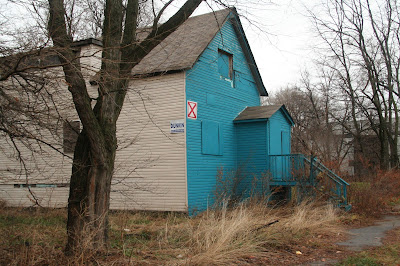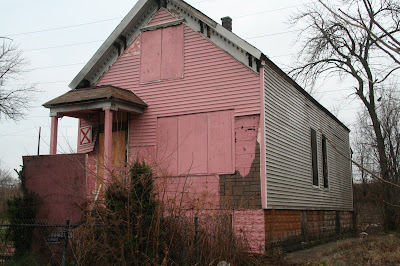Color(ed) Theory
This photo essay shows the work of an amazing artist, Amanda Williams who raises cultural awareness and inspires many through her work. In this specific projected, "The Color(ed) Series", Williams used a color pallet called "cultural signifiers" to repurpose houses with the designated colors. These colors show the unique experience of growing up Black on the south side of Chicago and colors that are associated with the experience. Originally there were eight houses, one for each color: Ultrasheen (turquoise), Pink Oil Moisturizer (pink), Harold's chicken (red), Crown Royal (purple), Currency Exchange (yellow) & Newport 100's (blue). Eight abandoned house scattered across Englewood were each assigned one of the eight colors and covered completely in the color. In Englewood, homeowners are being displaced and their houses torn down by the city to make way for the Northfolk Southern Railway. These brightly colored houses standing alone next to empty plots of land make a very bold statement. The attention that these houses (from people in the community and outside of it) receive raises awareness and questions about this serious situation.
Williams thought process for the project: "What if I create a 'Black space', like a mental space? So if I talk to ten other Black people that were my age, had the same experience and came from the similar walks of life, what things could I name where they would [say] "oh yeah" and know exactly what color I was talking about."
Ultrasheen Hair Oil

Pink Oil Moisturizer

Crown Royal Purple
"I wanted to apply the colors at another scale and see what the reaction would be. It was extremely conceptual and experimental [and] for me to see like as a painter and a architect, what happens when the two get smashed together. I didn't expect the onslaught of attention. I finished the project with the 8 colors, so the project has ended and now I'm thinking about the next stage." -Amanda Williams
"Five of the eight houses are still standing. And then you never know when they are going to go away, so I always get nervous when I drive past them, hoping they won't be gone. The way I found them was through the city data portal. The average people don't know that they have access to the information in the data portal and what is happening in these neighborhoods." -Amanda Williams
"Another thing that always stands out to me are the trees. I never really thought about trees and what this area was before it was a city, before it was populated. It makes you wonder what it will be like after." -Amanda Williamas
"We can be concerned on a microlevel but that doesn't necessarily translate to the bigger issue. There was also the question: would this make you so angry to see this that you'd want to exercise your rights or make you so happy to see this that you'd want to start painting or find out who I am?"
-Amanda Williams
"Lots of people in the area know about it and lots of people who aren't from the area know about it and are excited. But in this kind of 'art world' these become kind of like Amanda's art practice, so to a whole community of people there are no different from me painting on a canvas because they have no real investment in this neighborhood. They don't care to know who lives in the house."
-Amanda Williams
For almost a year i was keeping this a secret because i was very sensitive that someone from the neighborhood wouldn't want people running around my neighborhood like it is Disney World. So that wasn't the reaction they had, a lot of the people from the neighborhood liked that people came and engaged in dialogue and conversation and people asking them how they feel." -Amanda Williams
"I don't want make it sound to big but if it weren't for this project, a lot of those people wouldn't have an opportunity to share their opinion on this situation." -Amanda Williams










No comments:
Post a Comment